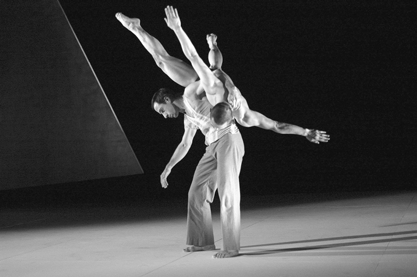Lyric dancing from a tanztheater wunderkind
By GUS SOLOMONS Jr.
Sasha Waltz is smart and lucky. A smartly striking set by Thomas Schenk and her, lit deftly by Martin Hauk, and the smart choice of Schubert music, plus the luck of finding luscious dancers, makes the Berlin-based choreographer’s “Impromptus” feel important enough to hold the stage of the Howard Gilman Opera House at BAM for most of its hour-and-a-quarter duration. Performances were December 6 and 8 to 10.
Onstage, a rectangular ramp, sloping toward the front abuts a trapezoidal one that’s raked toward the offstage side. On this fractured plane, the cast of seven undertakes a series of intriguing kinetic encounters. Behind them hangs an enormous wooden trapezoid that rises slightly to reveal glimpses of the feet of dancers about to enter from upstage.
Five Schubert impromptus and four songs accompany the piece, played by Cristina Marton on a grand piano that sits half submerged in the orchestra pit, and sung by Judith Simonis, standing either on the ramped stage, by the piano, or at the proscenium arch. When Simonis makes her first entrance in a white evening gown, a dancer gives the trapezoid a shove, turning it into a huge pendulum that continues swinging ever so subtly for the duration of the piece.
Long passages of dancing occur in silence between musical selections. The classical, tonal Schubert sets up an intriguing tension with the less formal, contact-based movement. In group tableaus, the dancers leverage their bodies against each other in super slow tempo, no-hands lifts. The most original dancing comes in duets, where partners lift each other mutually with seamless momentum. In the first one especially, Luc Dunberry and Maria Marta Colusi’s slippery intertwining is truly inventive.
Waltz’s reputation has been built on her theatrical, dance-theater pieces, like “Körper,” with which she made her Next Wave debut in 2002. “Impromptus,” however, is all about lyric dancing. Her knack for sculpting bodies into sensuous tableaus yields some visually exciting moments, but despite the formidable skill of her talented, attractive dancers, much of the movement looks like improvisation exercises—we’ve seen those moves in downtown lofts, done by equally talented dancers, who aren’t subsidized, like their more fortunate European counterparts.
When dancers “collaborate” with their choreographer in creating movement material, they inevitably tend to do what feels good or what they enjoyed doing in a favorite class—not necessarily something fresh. That leaves Waltz to shape and edit kinetic leftovers.
As the action progresses through paint smearing, sloshing around in water-filled galoshes, and bathing in pool that magically appears, the clever but irrelevant theatrics supplant motion as substance. To give Waltz her due, the final duet, where Garaio Esnaola leads a robotic Claudia de Serpa Soares, tenderly following and guiding her; then, his backing slowly away from her toward the edge of the stage and impending disaster, is wonderfully suspenseful.
gaycitynews.com


































